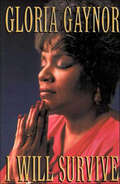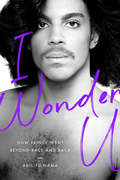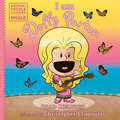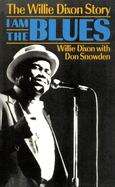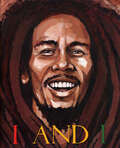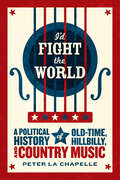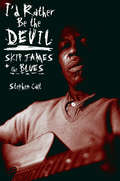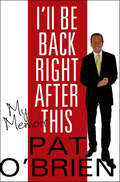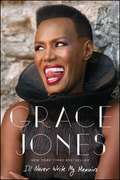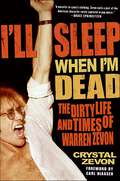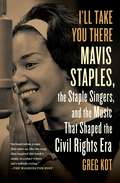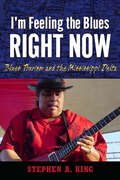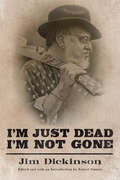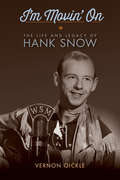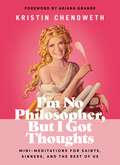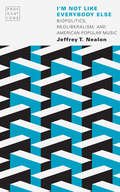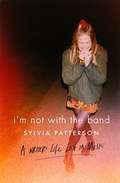- Table View
- List View
I Will Survive: A Children's Picture Book (LyricPop #0)
by Frederick J. Perren Dino FekarisDino Fekaris and Frederick J. Perren's disco hit sensation "I Will Survive"--popularized by Gloria Gaynor--comes to life as an empowering picture book featuring an alien princess living life on her own terms. "I will survive Oh,
I Will Survive: The Book
by Gloria GaynorI Will Survive is the story of Gloria Gaynor, America's "Queen of Disco." It is the story of riches and fame, despair, and finally salvation. Her meteoric rise to stardom in the mid-1970s was nothing short of phenomenal, and hits poured forth that pushed her to the top of the charts, including "Honey Bee," "I Got You Under My Skin," "Never Can Say Goodbye," and the song that has immortalized her, "I Will Survive," which became a #1 international gold seller. With that song, Gloria heralded the international rise of disco that became synonymous with a way of life in the fast lane - the sweaty bodies at Studio 54, the lines of cocaine, the indescribable feeling that you could always be at the top of your game and never come down. But down she came after her early stardom, and problems followed in the wake, including the death of her mother, whose love had anchored the young singer, as well as constant battles with weight, drugs, and alcohol. While her fans always imagined her to be rich, her personal finances collapsed due to poor management; and while many envied her, she felt completely empty inside. In the early 1980s, sustained by her marriage to music publisher Linwood Simon, Gloria took three years off and reflected upon her life. She visited churches and revisited her mother's old Bible. Discovering the world of gospel, she made a commitment to Christ that sustains her to this day.
I Wonder U: How Prince Went beyond Race and Back
by Adilifu NamaIn 1993, Prince infamously changed his name to a unique, unpronounceable symbol. Yet this was only one of a long string of self-reinventions orchestrated by Prince as he refused to be typecast by the music industry’s limiting definitions of masculinity and femininity, of straightness and queerness, of authenticity and artifice, or of black music and white music. Revealing how he continually subverted cultural expectations, I Wonder U examines the entirety of Prince’s diverse career as a singer, multi-instrumentalist, songwriter, producer, record label mogul, movie star, and director. It shows how, by blending elements of R&B, rock, and new wave into an extremely videogenic package, Prince was able to overcome the color barrier that kept black artists off of MTV. Yet even at his greatest crossover success, he still worked hard to retain his credibility among black music fans. In this way, Adilifu Nama suggests, Prince was able to assert a distinctly black political sensibility while still being perceived as a unique musical genius whose appeal transcended racial boundaries.
I Would Die 4 U: Why Prince Became an Icon
by TouréCelebrated journalist, TV personality, and award-winning author Touré investigates one of the most enigmatic and fascinating figures in contemporary American culture: Prince. Celebrated journalist, TV personality, and award-winning author Touré investigates one of the most enigmatic and fascinating figures in contemporary American culture: PRINCEDrawing on new research and enlivened by Touré's unique pop-cultural fluency, I Would Die 4 U relies on surprising and in-depth interviews with Prince's band members, former girlfriends, musicologists, and even Bible scholars to deconstruct the artist's life and work. Prince's baby boomer status allowed him to play a wise older brother to the latchkey kids of generation X. Defying traditional categories of race, gender, and sexuality, he nonetheless presents a very traditional conception of religion and God in his music. He was an MTV megastar and a religious evangelist, using images of sex and profanity to invite us into a musical conversation about the healing power of God. By demystifying the man and his music, I Would Die 4 U shows us how Prince defined a generation.
I Would Leave Me If I Could.: A Collection of Poetry
by HalseyGrammy Award–nominated, platinum-selling musician Halsey is heralded as one of the most compelling voices of her generation. In I Would Leave Me If I Could, she reveals never-before-seen poetry of longing, love, and the nuances of bipolar disorder. <p><p> In this debut collection, Halsey bares her soul. Bringing the same artistry found in her lyrics, Halsey’s poems delve into the highs and lows of doomed relationships, family ties, sexuality, and mental illness. More hand grenades than confessions, these autobiographical poems explore and dismantle conventional notions of what it means to be a feminist in search of power. Masterful as it is raw, passionate, and profound, I Would Leave Me If I Could signals the arrival of an essential voice. Book cover painting, American Woman, by the author. <p> <b>A New York Times Bestseller</b>
I am Dolly Parton (Ordinary People Change the World)
by Brad MeltzerAn instant New York Times Best Seller!The legendary country musician, reading advocate, and philanthropist Dolly Parton is the 28th in the New York Times bestselling picture book biography series for ages 5 to 8. (Cover may vary)This book spotlights Dolly Parton, known for her beloved country songs, who has also sent over 150 million free books to children through her Imagination Library. This friendly, fun biography series inspired the PBS Kids TV show Xavier Riddle and the Secret Museum. One great role model at a time, these books encourage kids to dream big. Included in each book are: • A timeline of key events in the hero&’s history • Photos that bring the story more fully to life • Comic-book-style illustrations that are irresistibly adorable • Childhood moments that influenced the hero • Facts that make great conversation-starters • A virtue this person embodies: Dolly Parton&’s love is seen in everything she does.You&’ll want to collect each book in this dynamic, informative series!
I am the Blues: The Willie Dixon Story
by Willie DixonI Am The Blues captures Willie Dixon's inimitable voice and character as he tells his life story: the segregation of Vicksburg, Mississippi, where Dixon grew up, the prison farm from which he escaped and then hoboed his way north as a teenager, his equal-rights-based draft refusal in 1942, his work--as songwriter, bassist, producer, and arranger--with Muddy Waters, Howlin' Wolf, Little Walter, Bo Diddley, and Chuck Berry which shaped the definitive Chicago blues sound of Chess Records: and his legal battles to recapture the rites to his historic catalog of songs. Don Snowden has supplemented Dixon's reflections with interviews with other performers and Chess insiders. In the Appendixes, Snowden gives a comprehensive discography and a list of the major artists who have recorded Dixon's songs.
I and I Bob Marley
by Tony MedinaA poetic biography of the Jamaican reggae legend Bob Marley, providing a glimpse into significant moments and themes from his life, such as his mixed-race background, Rastafarian faith, and passion for music. The book includes end notes with additional biographical details about the poems.
I and I Bob Marley
by Tony MedinaA biography in verse of reggae legend Bob Marley, exploring the influences that shaped his life and music on his journey from rural Jamaican childhood to international superstardom.Born in the Jamaican countryside in 1945, Bob Marley seemed special from birth. The curious, intuitive boy had an extraordinary gift for absorbing and interpreting the world around him. Influenced by his biracial heritage, his island home, and the injustices he observed in everyday life, Bob went on to become a musician and messenger; a poet and prophet of reggae culture. His music echoed from Jamaica all the way across the globe, spreading his heartfelt message of peace, love, and equality to everyone who heard his songs. Brimming with imagination and insight, I and I Bob Marley, is a multifaceted tribute befitting this international musical legend. Soulful, sun-drenched paintings transport readers to Bob Marley's Jamaica, while uniquely perceptive poems bring to life his fascinating journey from boy to icon.
I'd Fight the World: A Political History of Old-Time, Hillbilly, and Country Music
by Peter La ChapelleLong before the United States had presidents from the world of movies and reality TV, we had scores of politicians with connections to country music. In I’d Fight the World, Peter La Chapelle traces the deep bonds between country music and politics, from the nineteenth-century rise of fiddler-politicians to more recent figures like Pappy O’Daniel, Roy Acuff, and Rob Quist. These performers and politicians both rode and resisted cultural waves: some advocated for the poor and dispossessed, and others voiced religious and racial anger, but they all walked the line between exploiting their celebrity and righteously taking on the world. La Chapelle vividly shows how country music campaigners have profoundly influenced the American political landscape.
I'd Rather Be the Devil: Skip James and the Blues
by Stephen CaltProviding a clear look into the life of one of the greatest Mississippi bluesmen, this is the first biography of the late Skip James, perhaps the most creative and idiosyncratic of all blues musicians. His 1931 performances of "Devil Got My Woman," "I'm So Glad," and "22-20 Blues" are masterpieces that transcend the genre. Drawing largely on hundreds of hours of conversations with James himself, it paints a dark and unforgettable portrait of a man untroubled by his own murderous inclinations, a man who achieved one moment of transcendent greatness in a life haunted by failure. In doing so, it offers new insights into the nature of the blues, the world in which it thrived, and its fate when that world vanished.
I'll Be Back Right After This: My Memoir
by Pat O'BrienA New York Times Best seller!Pat O'Brien was a skinny South Dakota kid with long hair, a rock and roll band, divorced parents and an alcoholic father. In all the familiar ways, he was on the road to nowhere until a professor, who envisioned his future as the household name he would soon become, dramatically changed his life.From that day forward Pat's life took turns that were both spectacular and destructive: from the Huntley-Brinkley Report and afternoons at Bobby Kennedy's living room with Muhammad Ali to conversations with six Presidents. He did acid with Timothy Leary, drank with Mickey Mantle, and over the course of a remarkable career up close and personal with the Beatles, The Stones, The Kennedy's, Magic Johnson, Michael Jordan, Tiger Woods and virtually every star in Hollywood. In I'LL BE BACK RIGHT AFTER THIS, Pat reveals the highs and lows of the life of a radio and TV broadcaster, spent sharing the mic with the world's rich and famous while battling an infamous public scandal and demons that nearly killed him. With laughter, tears and miracles he reveals how he learned to accept his mistakes, find redemption and become the father he never had, proving there really are second and even third acts in life.
I'll Be Your Mirror: The Collected Lyrics
by Lou ReedAN UPDATED, COMPREHENSIVE COLLECTION OF LYRICS FROM THE VELVET UNDERGROUND FOUNDER AND SOLO ARTIST LOU REED, INCLUDING INTRODUCTIONS BY MARTIN SCORSESE, LAURIE ANDERSON, JAMES ATLAS, AND NILS LOFGRENI'll Be Your Mirroris an updated, comprehensive volume of Lou Reed's lyrics, featuring a brand-new introduction by Nils Lofgren and a new chapter of lyrics of songs he and Reed cowrote, as well as introductions from several other well-known collaborators and lyrics from Reed's final album with Metallica (Lulu). Through his many incarnations-from protopunk to glam rocker to elder statesman of the avant garde-Lou Reed's work has maintained an undeniable vividness and raw beauty, fueled by precise character studies and rendered with an admirable shot of moral ambiguity. Beginning with his formative days in the Velvet Underground and continuing through his remarkable solo albums like Transformer, Berlin, and New York, I'll Be Your Mirror is crucial to an appreciation of Lou Reed, not only as a consummate underground musician, but as one of the truly significant visionary lyricists of the rock 'n' roll era. Containing a body of work that spans more than six decades, this is a monument to the literary qualities of an American original-and a must-have for music lovers everywhere.
I'll Love You Forever: Notes from a K-Pop Fan
by Giaae KwonJia Tolentino’s Trick Mirror meets Cathy Park Hong’s Minor Feelings in a meditation that blends memoir and cultural criticism to explore how the author’s love affair with K-pop has shaped her sense of self, charting K-pop’s complex coming-of-age through some of its biggest idols.I’ll Love You Forever: Notes from a K-Pop Fan is a smart, poignant, constantly surprising essay collection that considers the collision between stratospherically popular music and our inescapably personal selves. Giaae Kwon delves into the global impact of K-pop artists, from H.O.T. to Taeyeon to IU to Suga of BTS, and reveals how each illuminated and shaped her own life.In using intimate experiences to examine larger cultural topics, this singular work breaks new ground in its consideration of K-pop. Written from the perspective of a bilingual and bicultural Korean American, I'll Love You Forever blends the critical with the personal. Kwon interweaves profiles of different K-pop idols with ruminations on various aspects of Korean culture, from the country’s attitude toward plastic surgery and female sexuality to its obsession with academia. Combining insightful critique and adoring analysis, I’ll Love You Forever provides readers with a fuller picture of a culturally and socially complex industry and the machine and heart behind its popularity. Above all, Kwon offers up the passion of a superfan, finding joy in K-pop along the way.
I'll Never Write My Memoirs
by Grace Jones Paul MorleyIconic music and film legend Grace Jones gives an in-depth account of her stellar career, professional and personal life, and the signature look that catapulted her into the stardom stratosphere. Grace Jones, a veritable “triple-threat” as acclaimed actress, singer, and model, has dominated the entertainment industry since her emergence as a model in New York City in 1968. Quickly discovered for her obvious talent and cutting-edge style, Grace signed her first record deal in 1977 and became one of the more unforgettable characters to emerge from the Studio 54 disco scene, releasing the all-time favorite hits, “Pull Up to the Bumper,” “Slave to the Rhythm,” and “I’m Not Perfect (But I’m Perfect for You). ” And with her sexually charged, outrageous live shows in the New York City nightclub circuit, Grace soon earned the title of “Queen of the Gay Discos. ” But with the dawn of the ’80s came a massive anti-disco movement across the US, leading Grace to focus on experimental-based work and put her two-and-a-half-octave voice to good use. It was also around this time that she changed her look to suit the times with a detached, androgynous image. In this first-ever memoir, Grace gives an exclusive look into the transformation to her signature style and discusses how she expanded her musical triumph to success in the acting world, beginning in the 1984 fantasy-action film Conan the Destroyer alongside Arnold Schwarzenegger, then the James Bond movie A View to a Kill, and later in Eddie Murphy’s Boomerang. Featuring sixteen pages of stunning full-color photographs, Miss Grace Jones takes us on a journey from Grace’s religious upbringing in Jamaica to her heyday in Paris and New York in the ’70s and ’80s, all the way to present-day London, in what promises to be a no holds barred tell-all for the ages.
I'll Sleep When I'm Dead: The Dirty Life and Times of Warren Zevon
by Crystal ZevonWhen Warren Zevon died in 2003, he left behind a rich catalog of dark, witty rock 'n' roll classics, including "Lawyers, Guns and Money," "Excitable Boy," and the immortal "Werewolves of London." He also left behind a fanatical cult following and veritable rock opera of drugs, women, celebrity, genius, and epic bad behavior. As Warren once said, "I got to be Jim Morrison a lot longer than he did."Narrated by his former wife and longtime co-conspirator, Crystal Zevon, this intimate and unusual oral history draws on interviews with Bruce Springsteen, Stephen King, Bonnie Raitt, and numerous others who fell under Warren's mischievous spell. Told in the words and images of the friends, lovers, and legends who knew him best, I'll Sleep When I'm Dead captures Warren Zevon in all his turbulent glory.
I'll Take You There: Mavis Staples, the Staple Singers, and the March up Freedom's Highway
by Greg KotThis is the untold story of living legend Mavis Staples--lead singer of the Staple Singers and a major figure in the music that shaped the civil rights era. Now in her seventies, Mavis has been a fixture in the music world for decades. One of the most enduring artists of popular music, she and her family fused gospel, soul, folk, and rock to transcend racism and oppression through song. Honing her prodigious talent on the Southern gospel circuit of the 1950s, Mavis and the Staple Singers went on to sell more than 30 million records, with message-oriented soul music that became a sound track to the civil rights movement--inspiring Martin Luther King Jr. himself. Critically acclaimed biographer and Chicago Tribune music critic Greg Kot cuts to the heart of Mavis Staples's music, revealing the intimate stories of her sixty-year career. From her love affair with Bob Dylan, to her creative collaborations with Prince, to her recent revival alongside Wilco's Jeff Tweedy, this definitive account shows Mavis as you've never seen her before. I'll Take You There was written with the complete cooperation of Mavis and her family. Readers will also hear from Prince, Bonnie Raitt, David Byrne, Marty Stuart, Ry Cooder, Steve Cropper, and many other individuals whose lives have been influenced by Mavis's talent. Filled with never-before-told stories, this fascinating biography illuminates a legendary singer and group during a historic period of change in America.
I'm Feeling the Blues Right Now: Blues Tourism and the Mississippi Delta (American Made Music Series)
by Stephen A. KingIn I’m Feeling the Blues Right Now: Blues Tourism and the Mississippi Delta, Stephen A. King reveals the strategies used by blues promoters and organizers in Mississippi, both African American and white, local and state, to attract the attention of tourists. In the process, he reveals how promotional materials portray the Delta’s blues culture and its musicians. Those involved in selling the blues in Mississippi work to promote the music while often conveniently forgetting the state’s historical record of racial and economic injustice. King’s research includes numerous interviews with blues musicians and promoters, chambers of commerce, local and regional tourism entities, and members of the Mississippi Blues Commission. This book is the first critical account of Mississippi’s blues tourism industry. From the late 1970s until 2000, Mississippi’s blues tourism industry was fragmented, decentralized, and localized, as each community competed for tourist dollars. By 2003–2004, with the creation of the Mississippi Blues Commission, the promotion of the blues became more centralized as state government played an increasing role in promoting Mississippi’s blues heritage. Blues tourism has the potential to generate new revenue in one of the poorest states in the country, repair the state’s public image, and serve as a vehicle for racial reconciliation.
I'm Just Dead, I'm Not Gone (American Made Music Series)
by Jim DickinsonI'm Just Dead, I'm Not Gone chronicles Jim Dickinson's extraordinary life in the Memphis music scene of the fifties and sixties and how he went on to play with and produce a rich array of artists, including Aretha Franklin, the Rolling Stones, Ry Cooder, Duane Allman, Arlo Guthrie, and Albert King. With verve and wit, Dickinson (1941–2009) describes his trip to Blind Lemon's grave on the Texas flatlands as a college student and how that encounter inspired his return to Memphis. Back home, he looked up Gus Cannon and Furry Lewis, began staging plays, cofounded what would become the annual Memphis Blues Festival, and started recording. The blues, Elvis, and early rock 'n' roll compelled Dickinson to reject racial barriers and spurred his contributions to the Memphis music and experimental art scene. He explains how the family yardman, WDIA, Dewey Phillips, Furry Lewis, Will Shade, and Howlin' Wolf shaped him and recounts how he went on to learn his craft at Sun, Ardent, American, Muscle Shoals, and Criteria studios from master producers Sam Phillips, John Fry, Chips Moman, and Jerry Wexler. Dickinson is a member of the Mississippi Music Hall of Fame and an inaugural inductee of the Memphis Music Hall of Fame. He has received the Lifetime Achievement Award for Engineering and Production from the Americana Music Association, a Brass Note on the Beale Street Walk of Fame in Memphis, and a Heritage Marker on the Mississippi Blues Trail. This memoir recounts a love affair with Memphis, the blues, and rock 'n' roll through Dickinson's captivating blend of intelligence, humor, and candor.
I'm Movin' On: The Life and Legacy of Hank Snow
by Vernon OickleA biography on the Canadian country musician, from his poor childhood in Nova Scotia to international celebrity on the stage of the Grand Ole Opry.Born in tiny Brooklyn, Nova Scotia, Hank Snow enjoyed a musical career that spanned five decades and sales of more than 80 million albums. In I’m Movin’ On, journalist Vernon Oickle chronicles Snow’s hardscrabble life, from his destitute childhood in Queens County to international fame. Leaving no stone unturned in his richly detailed profile of the Singing Ranger, Oickle exposes the highs and lows of Snow’s career, and his journey (“Everywhere, man,”) from small East Coast radio stations to the Grand Ole Opry in Nashville. Includes a foreword from Hank’s son, Jimmie Rodgers Snow, a timeline, discography, and 75 photographs.
I'm Movin' On: The Life and Legacy of Hank Snow
by Vernon OickleA biography on the Canadian country musician, from his poor childhood in Nova Scotia to international celebrity on the stage of the Grand Ole Opry. Born in tiny Brooklyn, Nova Scotia, Hank Snow enjoyed a musical career that spanned five decades and sales of more than 80 million albums. In I&’m Movin&’ On, journalist Vernon Oickle chronicles Snow&’s hardscrabble life, from his destitute childhood in Queens County to international fame. Leaving no stone unturned in his richly detailed profile of the Singing Ranger, Oickle exposes the highs and lows of Snow&’s career, and his journey (&“Everywhere, man,&”) from small East Coast radio stations to the Grand Ole Opry in Nashville. Includes a foreword from Hank&’s son, Jimmie Rodgers Snow, a timeline, discography, and 75 photographs.
I'm No Philosopher, But I Got Thoughts: Mini-Meditations for Saints, Sinners, and the Rest of Us
by Kristin ChenowethEnjoy some encouragement, laughter, and philosophical-ish musings on connection, creativity, loss, love, faith, and more!From television actress, Broadway star, and New York Times bestselling author Kristin Chenoweth comes I'm No Philosopher, But I Got Thoughts, an inspiring high-design, colorful book featuring philosophical-ish musings on connection, creativity, loss, love, faith, and closure. Just like Kristin's grandmother inspired her to trust her heart and develop her own belief system, you'll be inspired to develop your own life philosophies, as you journey through some of Kristin's most vulnerable and humorous personal stories, in her constant pursuit to make the most out of life.In each chapter, you'll find:Behind-the-scenes stories from Kristin's personal lifeHigh-design, colorful pages of inspirational quotesEngaging prompts, prayers, and inspiring quotes Oh, and a warning: There will be Bible verses. There will be f-bombs. Read responsibly.I'm No Philosopher, But I Got Thoughts is the perfect book to pick up on days when you need an extra shot of encouragement, a little laughter, and a gentle reminder that kindness can take you a long way. This is a great gift to give for birthdays, holidays, graduations, Mother's Day, or for fans of Kristin Chenoweth, known for her Emmy Award–winning role in the ABC hit series Pushing Daisies and Broadway's Wicked.
I'm Not Like Everybody Else: Biopolitics, Neoliberalism, and American Popular Music (Provocations)
by Jeffrey T. NealonDespite the presence of the Flaming Lips in a commercial for a copier and Iggy Pop’s music in luxury cruise advertisements, Jeffrey T. Nealon argues that popular music has not exactly been co-opted in the American capitalist present. Contemporary neoliberal capitalism has, in fact, found a central organizing use for the values of twentieth-century popular music: being authentic, being your own person, and being free. In short, not being like everybody else. Through a consideration of the shift in dominant modes of power in the American twentieth and twenty-first centuries, from what Michel Foucault calls a dominant “disciplinary” mode of power to a “biopolitical” mode, Nealon argues that the modes of musical “resistance” need to be completely rethought and that a commitment to musical authenticity or meaning—saying “no” to the mainstream—is no longer primarily where we might look for music to function against the grain. Rather, it is in the technological revolutions that allow biopolitical subjects to deploy music within an everyday set of practices (MP3 listening on smartphones and iPods, streaming and downloading on the internet, the background music that plays nearly everywhere) that one might find a kind of ambient or ubiquitous answer to the “attention capitalism” that has come to organize neoliberalism in the American present. In short, Nealon stages the final confrontation between “keepin’ it real” and “sellin’ out.”
I'm Not with the Band: A Writer's Life Lost in Music
by Sylvia PattersonSHORTLISTED FOR THE COSTA BIOGRAPHY AWARD 2016 'Celebratory and elegiac' Guardian 'A roller-coaster memoir' Sunday Times 'Funny, anecdote-packed, nostalgic but also very touching' The Pool'Patterson fillets out the pretentious bones of pop, leaving its glistening meat' Observer This is a three-decade survivor's tale . . . a scenic search for elusive human happiness through music, magazines, silly jokes, stupid shoes, useless blokes, hopeless homes, booze, drugs, love, loss, A&E, death, disillusion and hope. In 1986, Sylvia Patterson boarded a train to London armed with a tea-chest full of vinyl records, a peroxide quiff and a dream: to write about music, for ever. She got her wish. Escaping a troubled home, Sylvia embarks on a lifelong quest to discover The Meaning of It All. The problem is she's mostly hanging out with flaky pop stars, rock 'n' roll heroes and unreliable hip-hop legends. As she encounters music's biggest names, she is confronted by glamour and tragedy; wisdom and lunacy; drink, drugs and disaster. And Bros. Here is Madonna in her Earth Mother phase, flinging her hands up in horror at one of Sylv's Very Stupid Questions. Prince compliments her shoes while Eminem threatens to kill her. She shares fruit with Johnny Cash, make-up with Amy Winehouse and several pints with the Manics' lost soul-man Richey Edwards. She finds the Beckhams fragrant in LA, a Gallagher madferrit in her living room and Shaun Ryder and Bez as you'd expect, in Jamaica. From the 80s to the present day, I'm Not with the Band is a funny, barmy, utterly gripping chronicle of the last thirty years in music and beyond. It is also the story of one woman's wayward search for love, peace and a wonderful life. And whether, or not, she found them.
I'm Possible: A Story of Survival, a Tuba, and the Small Miracle of a Big Dream
by Richard Antoine WhiteFrom the streets of Baltimore to the halls of the New Mexico Philharmonic, a musician shares his remarkable story in I'm Possible, an inspiring memoir of perseverance and possibility.Young Richard Antoine White and his mother don't have a key to a room or a house. Sometimes they have shelter, but they never have a place to call home. Still, they have each other, and Richard believes he can look after his mother, even as she struggles with alcoholism and sometimes disappears, sending Richard into loops of visiting familiar spots until he finds her again. And he always does—until one night, when he almost dies searching for her in the snow and is taken in by his adoptive grandparents.Living with his grandparents is an adjustment with rules and routines, but when Richard joins band for something to do, he unexpectedly discovers a talent and a sense of purpose. Taking up the tuba feels like something he can do that belongs to him, and playing music is like a light going on in the dark. Soon Richard gains acceptance to the prestigious Baltimore School for the Arts, and he continues thriving in his musical studies at the Peabody Conservatory and beyond, even as he navigates racial and socioeconomic disparities as one of few Black students in his programs.With fierce determination, Richard pushes forward on his remarkable path, eventually securing a coveted spot in a symphony orchestra and becoming the first African American to earn a doctorate in music for tuba performance. A professor, mentor, and motivational speaker, Richard now shares his extraordinary story—of dreaming big, impossible dreams and making them come true.

